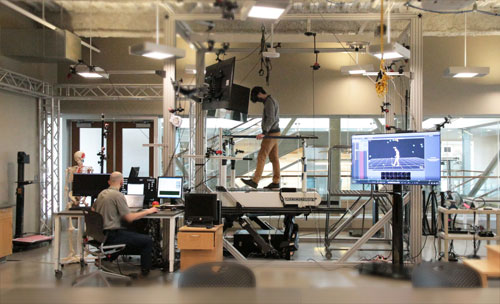Balance Impairments in People with Multiple Sclerosis
Loss of balance is one of the most common symptoms of Multiple Sclerosis (MS), affecting up to 75% of people over course of the disease. In fact, many people with MS identify balance impairment as the most disruptive symptom because it interferes with walking and increases the risk of falls. Disease-related changes in how people use their senses for balance may be a contributing factor and could suggesting alternative avenues for rehabilitation. Our lab is focused on understanding how vision is used for balance and whether visual feedback of body position can improve walking.
- Treadmill Testing
- Investigators during Treadmill Testing
- Virtual Reality Testing
Selected Publications
*Riem L., Beardsley S. A., Schmit B. D., (2021) The effect of visual field manipulations on standing balance control in people with multiple sclerosis, Gait & Posture, 90, p. 92–98. doi: 10.1016/j.gaitpost.2021.08.010.
*Reim L., Schmit B. D., Beardsley S. A., (2020), The Effect of Discrete Visual Perturbations on Balance Control during Gait, Conf Proc IEEE Eng Med Biol Soc., Montreal Canada. doi: 10.1109/EMBC44109.2020.9176303. PMID: 33018676.
*Riem L., *Van Dehy J., Onushko T., Beardsley, S. A., (2018), Inducing compensatory changes in gait similar to external perturbations using an immersive head mounted display, IEEE Conference on Virtual Reality and 3D User Interfaces, Reutlingen, Germany, p.1–8. doi: 10.1109/VR.2018.8446432
View more INSL Research
Join Us!
The team at the Integrative Neural Systems Laboratory is looking for hard-working students with an interest in human behavioral studies, multimodal brain imaging and computational modeling. For more information on how to become a student of the INSL, email Dr. Beardsley.






